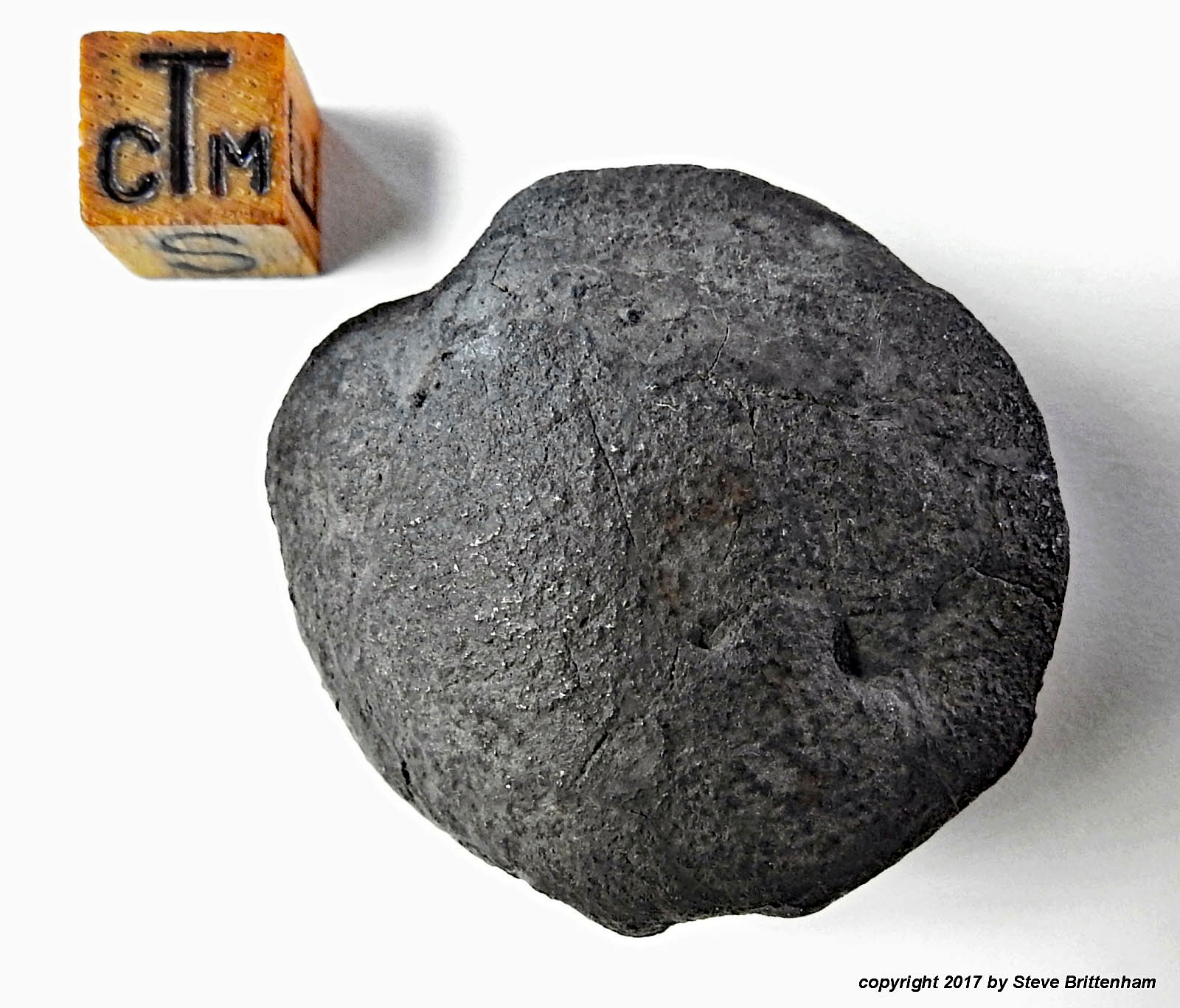|
Roll Overs:
#1
#2
|

|
|
Copyright (c) Steve Brittenham.
|
38.6 grams. 40 x 37 x 23 mm. H5
Observed fall March 5, 1960, in Burkina Faso.
From Wikipedia:
TKW probably over 1,000 kg. After three separate detonations, several thousands of stones rained down over an area of about 70 square kilometres (27 sq mi). The sound of the fall was heard as far as Ouagadougou, which is 100 kilometres (62 mi) away. Eyewitnesses said that some trees were broken and henhouses destroyed. The largest stones recovered weigh up to 10 kilograms (22 lb).
  
Steve writes:
Gao-Guenie is a well-known fall and consequently doesnít require much in the way of explanation. This particular example was given to me several years ago by Edwin Thompson of E.T. Meteorites. Itís not as large as some of the other Gao-Guenie MPOD submissions, or even as unusual as, say, Gary Fujiharaís unique 13.8 gram oriented stone with ďhitchhikersĒ from 11/3/2011, but it does have a couple of nice features that I thought made it worth submitting. Itís obviously oriented, and similar to my prior Murchison submission, apparently never tumbled, so the center portion of the backside is relatively undisturbed. While this piece purportedly came out of the Gao-Guenie strewn field, its interior does not appear consistent with other examples Iíve seen; that said, Gao Guenie is a breccia, so Iím guessing there was enough variation in the parent that itís just a less common lithology. The first photo depicts a fairly uninteresting leading edge; the second photo includes a few shots of the backside from different angles and with different lighting to show some of its features: frothy rollover lip, significant amounts of metal, and a surface appearance that for some reason makes me think of the moon. |
Click to view larger photos
#1
#2
|
Found at the arrow (green or red) on the map below
|
|
| |
Steve Brittenham
4/9/2017 12:31:33 PM |
Hi all. Thanks for all the great discussion and feedback! I understand how the photos may not make it obvious, but the voids are definitely vugs and not absent chondrules. And though I*ve seen breccia and melt in Gao pieces, the ELKKs are certainly some of the best (thanks for the reference!). I didn*t initially think this might be melt since the gray of this piece is much lighter than other Gaos or melt material I*ve seen or have, so thanks for that suggestion too. I always learn so much from you guys! |
Jansen Lyons
4/9/2017 9:22:16 AM |
Wow! That's remarkable Steve! A great and very unique Goa for sure, and in great condition. Excellent find!
God bless! |
MexicoDoug
4/9/2017 9:00:00 AM |
Agree this is of special interest, Mike. Herbert, an excellent macro image of a thin section is the 2 cm X 3 cm studied on the cover of MAPS 51:6, in Martin Schmieder et al.'s paper discussing the impact melt theory. Look on David Weir's site for a full size reproduction of the cover image on his Gao page. Note: the left is a color scanned image and the right is a super-duper high resolution reflected white light image of the same area produced by software manipulation seamlessly stitching together gigabytes of of patches. If Herbert is right and he probably is, the vugs on your specimen, and their placement, are certainly extremely uncommon in Gao ... not your run of the mill fragment! |
Mendy Ouzillou
4/9/2017 8:52:55 AM |
Great specimen and I fully agree with Herbert. Herbert, great explanation, you covered all the bases I intended to cover. |
John Divelbiss
4/9/2017 8:50:12 AM |
Impact melt for sure with gas bubbles would be my vote. I have a slice of Gao IM from Eric Olsen. If you search the name ELKK Meteorites you can see many slices of Eric's GAO impact melt. It was very special when first sold. |
Herbert
4/9/2017 4:48:14 AM |
Thanks, Steve, for sharing the images.
This specimen looks different from most other Gao-Guenie stones because it is impact melt, which looks different from the common H-chondrite lithology. (Quite similar as the impact melt specimens from Chelyabinsk look different from the common LL-chonrdite lithology.) Gao-Guenie is known to have delivered some impact melt specimens: A Google image search for "Gao Impacr Melt" will bring up several other specimens.
I would also suggest that the "moon craters" are bubbles in the impact melt, rather than chondrule sockets. Flaking of fusion crust is also a feature well known from other impact melt stones (also well known in Chelyabisk). |
Dr. Mike Reynolds
4/9/2017 4:25:32 AM |
Nice meteorite -- terrific background and discussion! Both your initial post Steve, and MexicoDoug's comments... all of this got me thinking, and perhaps after I have a couple of cups of coffee, I'll add o the discussion.
Mike |
MexicoDoug
4/9/2017 3:22:38 AM |
Do you think the "moon" craters are nicely defined chondrule sockets? There was a lot of confusion about whether more than one fall was represented here, or if falls were intermixed. Guenie was originally classified as H4 before it was consolidated with Gao as a single fall. Interesting that the back portion of the stone's fusion crust flaked off where it did. Do you think it was just because that it perched comfortably as a small domed pebble on its stern and was subject to more weathering on the contact area? Thanks again Steve! |
| |
|